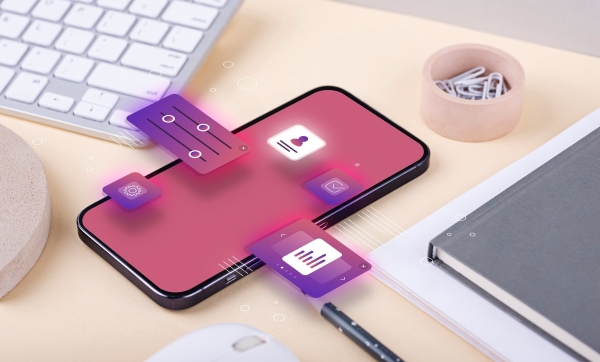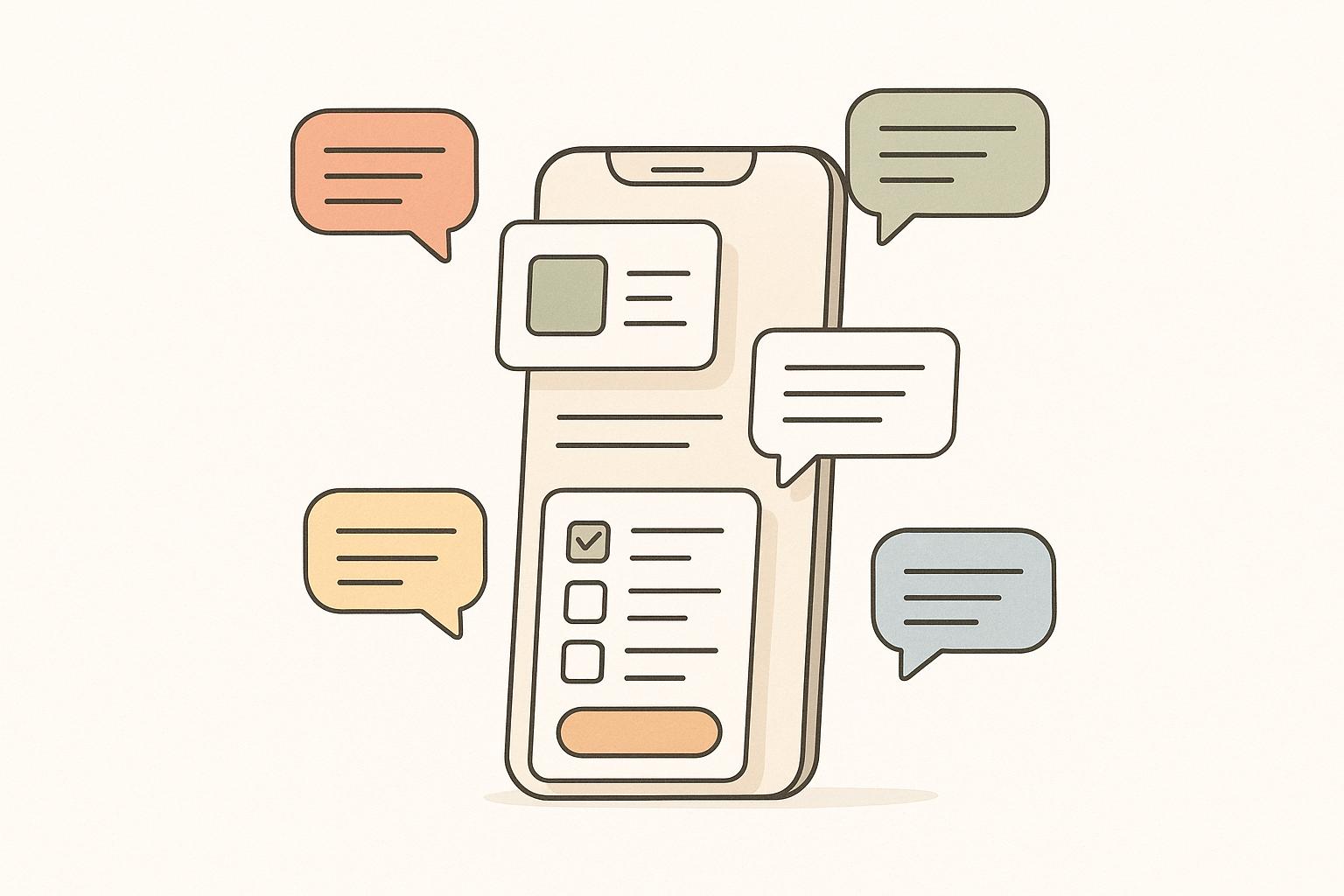In 2024, creating exceptional custom app UI/UX is crucial for driving business success. This guide covers key trends, best practices, and essential tools for designing engaging user experiences:
Key Trends in 2024:
TrendDescriptionAugmented Reality (AR) / Virtual Reality (VR)Create immersive experiencesAI IntegrationEnhance user experiences and streamline functionality
UI/UX Best Practices:
- Integrate new trends like AR, VR, and AI-driven personalization
- Balance aesthetics and performance through optimization techniques
- Make data-driven design decisions based on user analytics
- Maintain consistent branding across all platforms
- Conduct iterative design and user testing for continuous improvement
Top Design Tools:
ToolDescriptionSketchVector-based UI designFigmaCloud-based collaboration and prototypingAdobe XDComprehensive design and prototypingInVisionInteractive prototyping and feedback
To stay ahead, designers must embrace new technologies, upskill continuously, and remain open to innovative approaches that create personalized, intuitive, and visually appealing app experiences.
Related video from YouTube
Understanding UI and UX for Custom Apps
UI and UX: Keys to App Success
In custom apps, UI (User Interface) and UX (User Experience) are two connected aspects that play a crucial role in enhancing user satisfaction and driving business growth. UI refers to the visual and interactive elements of an app, such as buttons, screens, and menus, that users interact with to achieve their goals. UX encompasses the entire user journey, including their emotions, behaviors, and motivations, to create a seamless and personalized experience.
By 2024, UX design has evolved to focus on personalization, accessibility, and interactivity. Custom apps must incorporate these elements to provide users with a tailored experience that meets their unique needs and preferences. This includes leveraging AI-driven features, such as chatbots and voice UI, to create a more intuitive and human-centered experience.
Business Benefits of Well-Designed UI/UX
A well-designed custom UI/UX can have a significant impact on a business's bottom line. Here are some benefits:
BenefitDescriptionIncreased Conversion RatesProvide an intuitive and engaging experience to increase conversion ratesCustomer LoyaltyCreate a seamless and personalized experience to build customer loyaltyRevenue GrowthDrive revenue growth by providing a unique and engaging experienceCompetitive DifferentiationSet your business apart from competitors with a well-designed UI/UXReduced Development CostsIdentify and address user needs and pain points early on in the development process
User Research and Personas for Custom Apps
To create a successful custom app, it's essential to conduct thorough user research and create detailed user personas. This involves understanding the target audience's needs, goals, behaviors, and motivations to tailor the app's UI/UX effectively. User research can be conducted through various methods, including:
- Surveys
- Interviews
- Usability testing
By creating user personas, businesses can develop a deeper understanding of their target audience and design an app that meets their unique needs and preferences. This includes identifying pain points and areas of improvement, as well as opportunities to create a more engaging and personalized experience.
Design Elements for Custom App UI/UX
When creating a custom app, it's essential to consider various design elements that contribute to a seamless user experience. In this section, we'll explore the crucial aspects of custom app UI/UX design, including simplicity, responsiveness, interaction, and navigation.
Simplicity in App Design
A simple design approach is vital in custom app development. By focusing on essential features and eliminating clutter, you can ensure an intuitive and user-friendly experience. To achieve simplicity, consider the following:
Design ElementDescriptionClear typographyUse clear, readable fonts to communicate information effectively.Consistent layoutEstablish a consistent layout throughout the app to create a sense of familiarity.Limited color paletteSelect a limited color palette to avoid visual overload and ensure a cohesive look.
Responsive Design Across Devices
With the increasing use of various devices, it's crucial to optimize your custom app for different screen sizes, orientations, and devices. Responsive design ensures a smooth user experience across all platforms, including:
DeviceDesign ConsiderationsSmartphonesDesign for both portrait and landscape modes.TabletsOptimize for larger screens and different orientations.DesktopsEnsure a seamless experience on desktop devices.
Interactive Elements and User Feedback
Interactive elements, such as animations and transitions, can enhance the user experience. However, it's essential to provide immediate and clear user feedback to maintain engagement. Consider the following:
Interactive ElementDescriptionLoading animationsUse loading animations to indicate progress and reduce frustration.Error messagesDisplay clear and concise error messages to guide users.Success notificationsProvide positive feedback for successful actions.
Easy App Navigation
Easy navigation is critical to a seamless user experience. By providing a logical and consistent navigation structure, you can reduce friction and increase user satisfaction. Consider the following:
Navigation ElementDescriptionClear navigation patternsEstablish a clear navigation pattern throughout the app.Minimal navigation optionsLimit navigation options to avoid overwhelming users.Consistent iconographyUse consistent icons and graphics to create a sense of familiarity.
By incorporating these design elements, you can create a custom app that provides a seamless and engaging user experience. In the next section, we'll explore the best practices for custom app UI/UX design in 2024.
sbb-itb-8abf120
UI/UX Best Practices for 2024
Integrating New UX Trends and Tech
To stay ahead in the game, UI/UX designers must incorporate the latest trends and advancements into their designs. In 2024, some of the most significant trends to consider include:
Trend/TechnologyDescriptionAugmented Reality (AR) / Virtual Reality (VR)Create immersive and interactive experiences for users, particularly useful for industries like gaming, retail, and real estate.AI-Driven PersonalizationUse AI and machine learning to analyze user data and provide personalized experiences tailored to individual preferences and behaviors.Emphasis on AccessibilityEnsure your app is accessible to users with disabilities by following the latest accessibility guidelines and best practices.
Balancing Aesthetics and Performance
While aesthetically pleasing designs are essential for user engagement, it's crucial not to compromise on performance. To strike the right balance, consider the following:
1. Optimize Media Files: Compress images, videos, and other media files to reduce file sizes without compromising quality, improving load times and overall performance.
2. Leverage Caching Techniques: Implement caching strategies to store frequently accessed data locally, reducing the need for constant server requests and improving app responsiveness.
3. Adopt Progressive Web App (PWA) Technologies: PWAs combine the best of web and native apps, offering fast load times, offline functionality, and seamless updates.
Data-Driven Design Decisions
UI/UX designers have access to a wealth of information about user preferences, behaviors, and pain points. By leveraging data analytics tools and techniques, designers can make informed decisions that lead to more tailored and effective user experiences. Consider the following:
1. User Behavior Analytics: Analyze user interactions, click patterns, and navigation paths to identify areas for improvement and optimize the user journey.
2. A/B Testing: Conduct A/B tests to compare different design variations and determine which elements resonate best with your target audience.
3. User Feedback and Sentiment Analysis: Gather and analyze user feedback, reviews, and social media sentiment to understand user pain points and preferences better.
Consistent Branding Across Platforms
In today's multi-device world, users expect a consistent brand experience across all platforms and devices. A cohesive UI/UX design not only enhances brand recognition but also builds trust and loyalty among users. To achieve this, consider the following:
1. Develop a Comprehensive Design System: Create a design system that defines the visual language, components, and guidelines for your brand, ensuring consistency across all digital touchpoints.
2. Responsive and Adaptive Design: Implement responsive and adaptive design techniques to ensure your app's UI/UX seamlessly adapts to different screen sizes and device types.
3. Consistent Messaging and Tone: Maintain a consistent brand voice and messaging across all platforms, reinforcing your brand's identity and values.
Iterative Design and User Testing
UI/UX design is an iterative process that should be continuously refined based on user feedback and testing. By involving users throughout the design process, you can ensure that your app meets their evolving needs and expectations. Consider the following:
1. Conduct Usability Testing: Regularly test your app with real users to identify usability issues, pain points, and areas for improvement.
2. Gather User Feedback: Implement feedback mechanisms within your app to collect user feedback and suggestions for future updates and improvements.
3. Embrace Agile Methodologies: Adopt agile development methodologies that allow for rapid iteration and continuous improvement based on user feedback and testing results.
By following these best practices, you can create custom app UI/UX designs that not only meet but exceed user expectations in 2024 and beyond.
UI/UX Design Tools for 2024
In 2024, UI/UX designers have a wide range of powerful tools and software to create exceptional custom app experiences. These tools help maintain design consistency, streamline workflows, and facilitate collaboration among team members.
Top Design Tools in 2024
ToolDescriptionSketchA popular vector-based design tool for creating user interfaces and digital assets.FigmaA cloud-based design and prototyping tool for real-time collaboration and design systems.Adobe XDA comprehensive tool for designing, prototyping, and sharing user experiences, integrated with other Adobe products.InVisionA leading prototyping and collaboration platform for creating interactive prototypes and gathering feedback.
Creating a Design System
A design system is a set of guidelines, components, and principles that govern the visual language and interaction patterns of an app or product. To create a design system, follow these steps:
1. Define Design Principles Establish guiding principles that align with the brand's values and the desired user experience.
2. Establish a Component Library Create a collection of reusable UI elements, such as buttons, icons, and typography styles.
3. Document Design Patterns Document reusable solutions to common design problems, such as navigation structures and content layouts.
4. Facilitate Collaboration and Handoff Use design systems to facilitate collaboration among designers, developers, and stakeholders, ensuring a consistent and accurate final product.
By leveraging these powerful UI/UX design tools and establishing a robust design system, designers in 2024 can create custom app experiences that are visually appealing, intuitive, and consistent across all platforms and devices.
The Future of Custom UI/UX Design
The world of custom UI/UX design is constantly evolving. To stay ahead, it's crucial to understand the latest trends, best practices, and emerging technologies. This guide has provided a comprehensive overview of the essential insights and trends shaping the custom app development industry.
Key Takeaways
In the future of custom UI/UX design, we can expect:
- Personalized experiences: Users will expect tailored interactions and interfaces.
- Seamless interactions: Designers will focus on creating intuitive and natural interactions.
- AI, AR, and VR adoption: These technologies will continue to revolutionize the way we design and interact with digital products.
Staying Ahead of the Curve
To succeed in this rapidly evolving landscape, designers must:
- Stay informed: Keep up-to-date with the latest trends, technologies, and best practices.
- Upskill and reskill: Continuously develop new skills to meet the demands of the industry.
- Embrace change: Be open to new ideas and approaches to stay ahead of the curve.
By following these principles, we can create custom app experiences that provide real value to users and drive business success.








